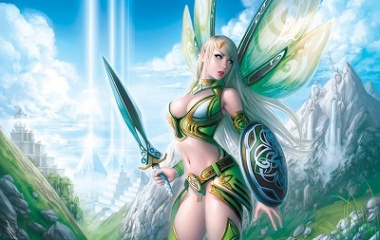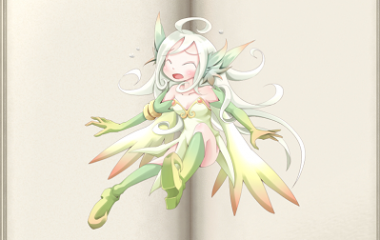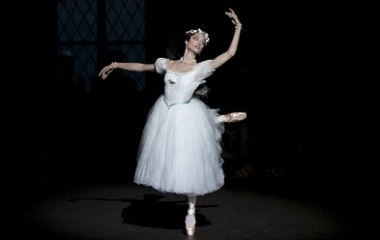Hidden just inside the clouds is a thriving society of ethereal beings, so pure that they cannot be seen by the eyes of men. Still, the invisible Sylphs have managed to captivate the imagination of people for over six centuries, inspiring songs, debates, dances, and even occult rituals.
What Is a Sylph?
A Sylph (also known as Sylphid) is an air spirit. They are formed of air, they live in the air, and they have unusual power over the air, particularly the wind and the clouds. Usually, Sylphs are portrayed as guardians who protect secret knowledge, beautiful women, or the environment, but it’s not out of the question for a Sylph to cause mischief among men.
Characteristics
Physical Description
From the dawn of Sylph mythology in the 16th century, and throughout the classical era, Sylphs have been described as being something between a spirit and a creature. While they are invisible to human beings, they do have physical bodies—usually coarse, humanoid shapes that are larger and stronger than those of regular humans.
As the curtain closed on the classical era, Sylphs materialized in the spotlight of the romantic era’s operas and ballets. Here, not surprisingly, Sylphs take on a more romantic shape; they are dainty, fairy-like creatures with graceful wings.
Today, the word Sylph is tagged onto slender, attractive young females, much like the ballerinas who portrayed Sylphs during the romantic period. However, a camp of believers in the original Sylph still puts out a large volume of photos every year, claiming that they have captured one of the elusive Sylphs leering down from the clouds.
Special Abilities
Sylphs have more than just invisibility and brawn going for them. They also have a type of intelligence that men lack. They are born understanding the universe and the connections between all its parts, and they may know of ways of manipulating those parts to cause specific effects, knowledge which caused many alchemists to pursue them throughout the classical era. Perhaps the most impressive aspect of Sylph intelligence is their supernatural foresight. The future holds few mysteries for a Sylph.
Weaknesses
According to early mythology, Sylphs are only capable of moving freely through the air. They drown in water, burn in fire, and become trapped in earth, so they are basically powerless outside of their own element.
Early mythology also states that Sylphs are mortal in both body and soul. They can die from hunger, illness, or physical injury. Because they lack a soul, when they die, they simply cease to exist. Luckily, there is a loophole for Sylphs who marry humans; the Sylph might gain an immortal soul through the marriage. At the very least, the couple’s children will have immortal souls.
Related Characters
According to early Sylph mythology, the Sylph is one of four creatures, called elementals, who embody the cardinal elements. Sylphs, of course, embody air, while gnomes embody earth, salamanders embody fire, and undines embody water. The elementals guard great treasures of power and knowledge, which are hidden in the pure worlds of each element.
Occasionally, all of the elementals are capable of giving rise to monstrous offspring. The birth of one of these monsters is rare and apparently spontaneous, but disaster usually follows at their heels. When a Sylph delivers one of these monsters, it takes the form of a giant.
Over time and through cultural shifts, the Sylph became estranged from the other three elementals and were linked, instead, to air spirits like fairies and pixies. They also filled the void left by the sirens of classical mythology, becoming a slightly more innocent version of the seductive, magical creature who lures men to their doom.
Cultural Representation
Origin
Sylphs make their debut on the pages of the Liber de Nymphis, which was penned during the 16th century by Paracelsus, a renowned Swiss-German occultist. Not only was Paracelsus the first to refer to Sylphs in writing, he gave such a definitive study of them that his name became a fixture in Sylph mythology. For hundreds of years, no discussion of Sylphs failed to include Paracelsus’ name.
Paracelsus himself made no claims about seeing Sylphs. Instead, he credited his knowledge of these air spirits to folklore; his study of the Sylph attempted to fit accounts from folklore into his own worldview. By the end of his analysis, Paracelsus made it clear that his own understanding of Sylphs was much more advanced than the folklore he had based his ideas on, stating that, “The names have been given [to Sylphs] by people who did not understand them.”
Classical Era
The political turmoil of the early 17th century created a hotbed for cults who offered clarity and knowledge to their followers. The Sylph, who was believed to possess both, emerged as a figurehead of some prominent cult movements, including Rosicrucianism.
The Rosicrucians claimed to be capable of seeing Sylphs, as well as the other elementals, by treating their eyes with alchemical medicines or gazing into crystal balls. Many Rosicrucians took chastity vows, hoping to marry an elemental.
Romantic Era
By the time the 19th century rolled around, bringing greater stability to European society, the occult beliefs that had raged during the 17th century had become the stuff of satire.
The Sylph found a safe-haven in the theaters of the romantic period. They appeared as charming, ethereal, and ultimately unattainable women in multiple operas and ballets. Perhaps the most famous ballet was La Sylphide, which immortalized the image of the graceful, fairy-like Sylph.
Modern Era
Thanks to Vladimir Nabokov’s society-shaking novel, Lolita, most people today would define a “sylph” as an enchanting, slightly devious young girl.
Role-playing games, like Dungeons and Dragons, have stayed truer to the original meaning of the word “sylph.” Players often incorporate Sylphs into their games as strong, magical creatures with power over the wind.
There are still some pockets of believers in the elemental Sylph. They frequently photograph Sylphs in the clouds and describe the Sylph as a valiant protector of the environment. One of their pet beliefs is that, in order to eliminate pollution, Sylphs eat the harmful “chemtrails” left behind by airplanes.











Ah yes, the “Sylph in game” image is from an eroge game, apart from that great article
Congratulations on finally bringing them to light! I have been researching the web for more information on sylphs, and I finally found it here! Well done, you!
Nice information!